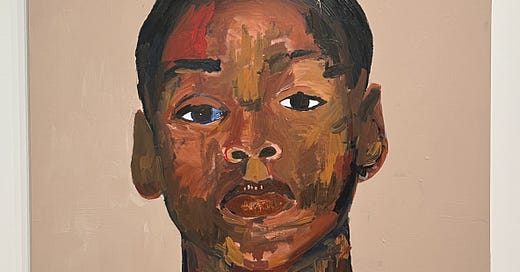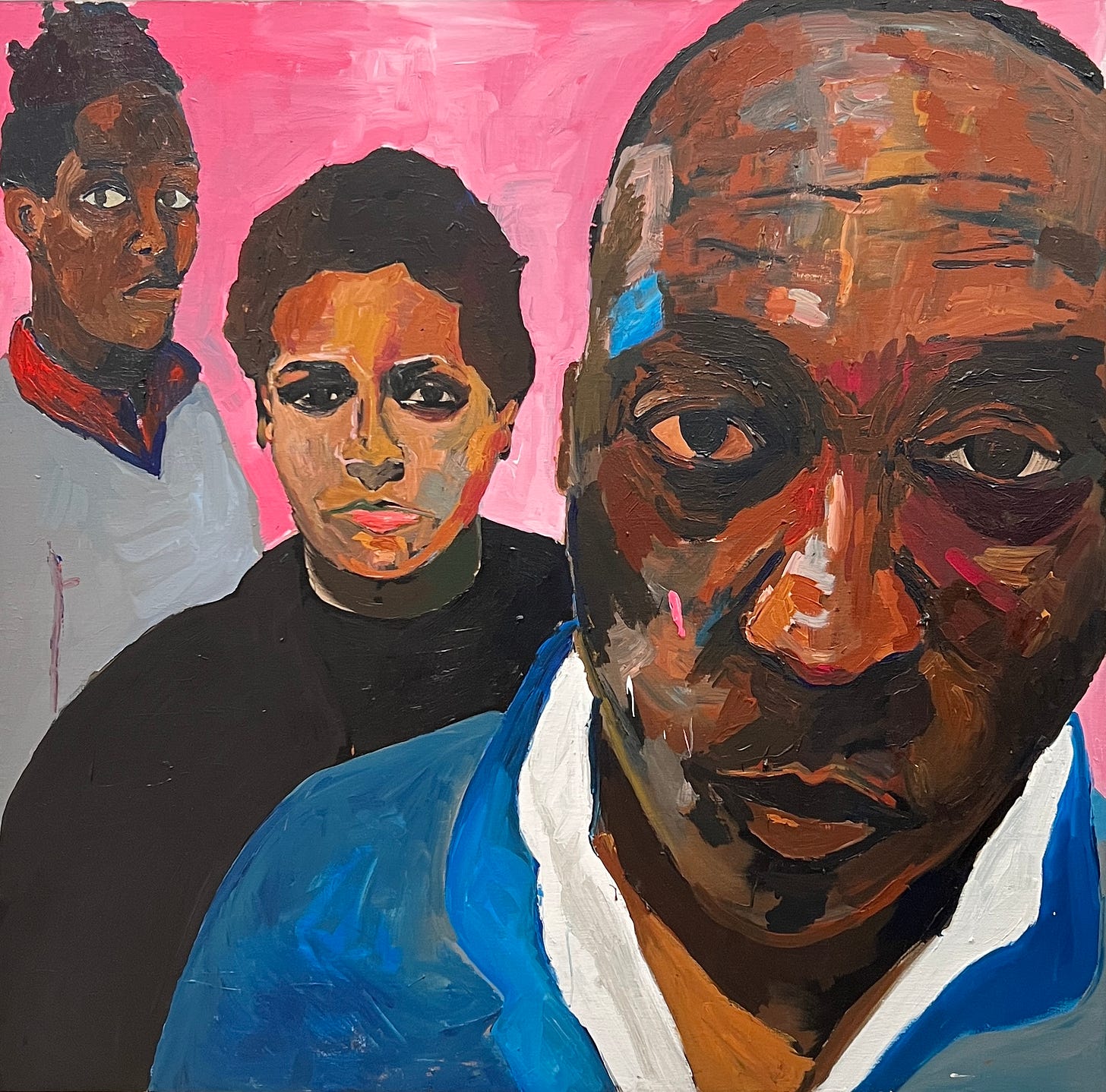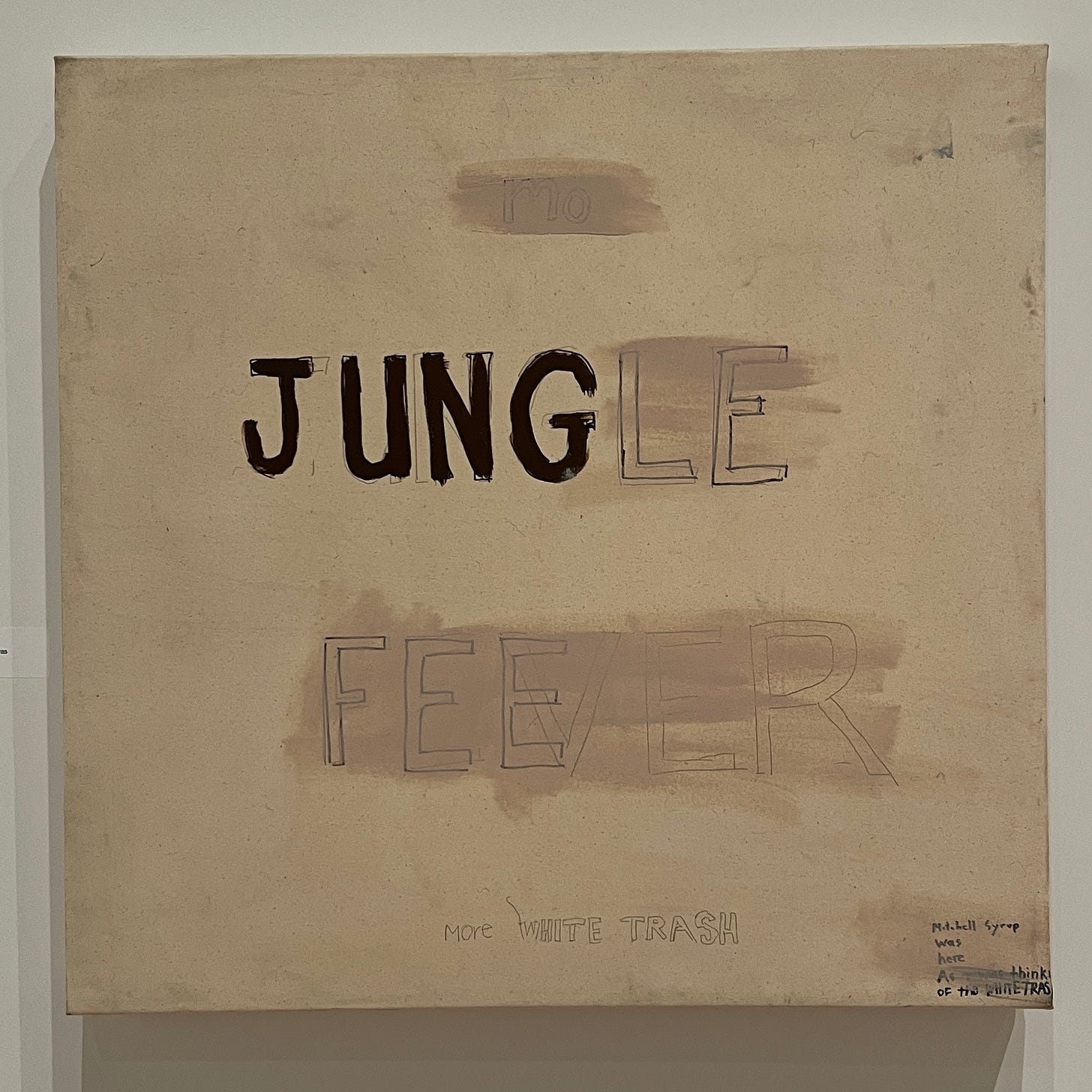The first thing that struck me when I walked into Henry Taylor’s hypnotizing survey at the Whitney is how photography doesn’t just lie, it debases certain kinds of painting. I’ve never seen a decent reproduction of a Taylor work online, which is why I got so annoyed with all the early bird curators I follow on Instagram posting every damn picture in the show before anyone could see it. Yeah, you were at the opening and got carried away. Don’t do that! It’s worse than futile to think that the more pictures you show us, the better we will understand why Taylor is the boss right now. You won’t get the big deal if you haven’t stood in front of the thing itself.
In fact, I can easily imagine him being systematically dismissed by countless magazine flippers, which breaks my heart. Take the picture above; if you only have this jpg to go by, you will think I’m nuts when I say that it bolted me to the floor fighting back tears. First off, it’s as big as a Thomas Ruff headshot from the 1980s (they’re big). Scale is crucial in Taylor’s work; he has a gift for it and never misses giving a picture exactly the size it needs, something also mastered by Basquiat who’s ghostly presence snuck up on me a few times as I moved, very slowly, from work to work.
This is the portrait of another vivid ghost, the painter Noah Davis, a friend of the artist who died of cancer at 32. (There’s a good Davis up at MoMA right now). To memorialise him, Taylor paints the child he had once been, which is more emotionally strategic of him than sentimental. Although it is likely based on a photograph, this is 100% painting. In my mind, it’s a monumental deconstruction of Fauvism as if it had had baroque intentions and deep psychological insights (it did not).
The work vibrates almost audibly. There is so much bluntly applied, nay, constructed colour in the picture that the sitter’s expression changes uncannily from moment to moment. I kept failing to take it in. I have never seen a posthumous portrait this dynamic, this alive and mutable. Like so many works in the show, you feel a love and a solidarity that had yet to be painted.
For me, the disappointment of this show is the absence of Reflecting. I so wanted to see my first Taylor again from the 2017 Whitney Biennial. I may be wrong but I remember it hanging in the same room as the picture of Emmett Till in his open coffin by Dana Schutz. You could only just glimpse that one behind a phalanx of shunners. The scowling protesters didn’t inconvenience me because I don’t cotton to Schutz’s schtick. I took a quick peek over a shoulder to see if I too would be offended. It turns out that, yeah, I did not need to see this subject painted in a ‘signature style’. Later, once the quiet brilliance of the Taylor picture reached my distracted consciousness, I became appalled by the irony clotting the room: it was all about a White woman’s failure rather than a Black man’s success, so I started resenting the shunners.
I’m Yours is the main attraction in the room where it hangs now so justice is served. You could learn a lot about Taylor’s secret sauce by studying it. He doesn’t have a schtick; if he does it’s imperceptible to me. Taylor doesn’t repeat himself and works variously from life, photographs, memory or imagination. That gives a roomful of his pictures a variety just shy of a group show effect, but his unique personality, rather than any coherent style, holds things together.
I’m Yours is startling in person, and not just because it’s big. A self-portrait with his kids, Taylor’s face takes up half the canvas as it bows-up to meet the viewer’s gaze. Gauguin does that too sometimes. Interestingly, this is among his most conventionally skilled depictions, almost as if someone else had painted him. His children recede diagonally behind his right shoulder. I read that his daughter was not in the photograph this work is based on, so her portrait is invented. But that’s only partially why she stands out. The three people are painted as differently as their differing (but synonymously neutral) attitudes toward the viewer. They are so emphatically individual that I started to think about the psychological varieties of fatherhood. Unlike countless photographs copied by painters, the one Taylor used here is all used up and out of the picture.
This picture could have used an extended label, but I can see why a museum would be struck dumb by it. As exposures of racism go, this is high-brow stuff in low-brow drag with booby traps for the unwary. Who gets to speak about a non-scientific cultural construct as fraught as race is the question of the day. The common sense to let the racialised have both the first and last word seems to be the contemporary consensus. But real change requires the descendants of the racialists, such as in Florida and Texas, to work it through in uninhibited self-examination. Jung might have agreed with that, despite his shortcomings on the issue.
In any case, here’s an excellent example of textual pentimento. The work is an unspoken homage to Jean-Michel Basquiat who famously explored the pictorial uses of text upon which this is a candid riff. Basquiat was only ever young and not known for NYRB-grade wit. Taylor was 53 when he painted it, so the nod also feels like a hypothetical extension of Basquiat’s project, imagining him as a cultured, middle-aged wag.
If you don’t get the dark humour, check out Spike Lee’s Jungle Fever of 1991, a film about marital infidelity via Black/White romance. Also note that Carl Jung’s white supremacist blinkers are well documented. Taylor whispers as much with the derisive “more white trash” at the bottom of the picture. Although the famous psychoanalyst did go to Africa, Marlene Dietrich’s “Hot Voodoo” number from von Sternberg’s Blond Venus (1932), may have made a stronger impression. That’s the one where she emerges from a gorilla suit in a blond afro. Taylor’s sotto voce commentary reminds me of Basquiat the graffiti poet (he was never a graffiti artist), who wrote as “SAMO,” short for same ol’ shit, echoed by the “more white trash” reference to Jung. Or is it to the ghastly concept of miscegenation ghosted here? I notice from the credit that the work may still be available. No, I’m not encouraging anyone to buy it because as soon as I win the lottery this hot property will be mine.







Loving your thought provoking, want to look more closely because you make me think writings.